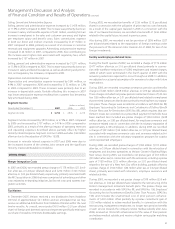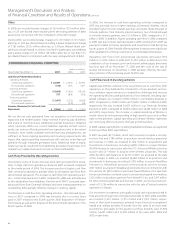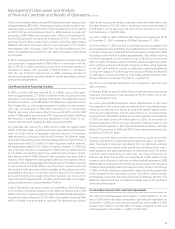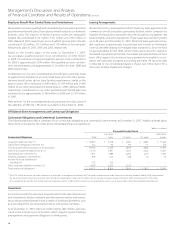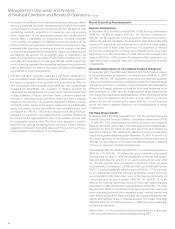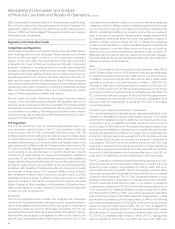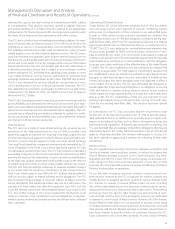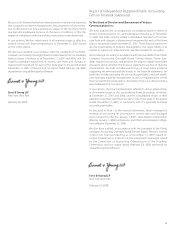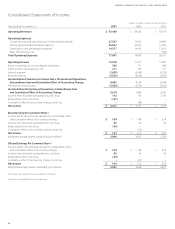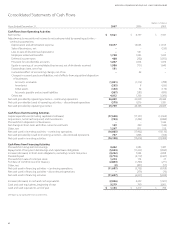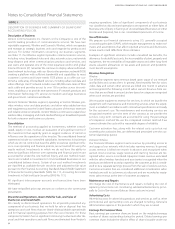Verizon Wireless 2007 Annual Report Download - page 36
Download and view the complete annual report
Please find page 36 of the 2007 Verizon Wireless annual report below. You can navigate through the pages in the report by either clicking on the pages listed below, or by using the keyword search tool below to find specific information within the annual report.
2005, we provided a detailed rebuttal to the preliminary audit findings.
We received a copy of the final audit report for Verizon’s Category One
applications largely confirming the preliminary audit findings and, on
January 4, 2007, we filed an appeal. That appeal, as well as our Category
Two applications, are pending.
Regulatory and Competitive Trends
Competition and Regulation
Technological, regulatory and market changes have provided Verizon
both new opportunities and challenges. These changes have allowed
Verizon to offer new types of services in an increasingly competitive
market. At the same time, they have allowed other service providers
to broaden the scope of their own competitive offerings. Current and
potential competitors for network services include other telephone
companies, cable companies, wireless service providers, foreign telecom-
munications providers, satellite providers, electric utilities, Internet service
providers, providers of VoIP services, and other companies that offer net-
work services using a variety of technologies. Many of these companies
have a strong market presence, brand recognition and existing customer
relationships, all of which contribute to intensifying competition and may
affect our future revenue growth. Many of our competitors also remain
subject to fewer regulatory constraints than Verizon.
We are unable to predict definitively the impact that the ongoing
changes in the telecommunications industry will ultimately have on our
business, results of operations or financial condition. The financial impact
will depend on several factors, including the timing, extent and success
of competition in our markets, the timing and outcome of various regula-
tory proceedings and any appeals, and the timing, extent and success of
our pursuit of new opportunities.
FCC Regulation
The FCC has jurisdiction over our interstate telecommunications ser-
vices and other matters for which the FCC has jurisdiction under the
Communications Act of 1934, as amended (Communications Act). The
Communications Act generally provides that we may not charge unjust
or unreasonable rates, or engage in unreasonable discrimination when
we are providing services as a common carrier, and regulates some of the
rates, terms and conditions under which we provide certain services. The
FCC also has adopted regulations governing various aspects of our busi-
ness including: (i) use and disclosure of customer proprietary network
information; (ii) telemarketing; (iii) assignment of telephone numbers to
customers; (iv) provision to law enforcement agencies of the capability to
obtain call identifying information and call content information from calls
pursuant to lawful process; (v) accessibility of services and equipment to
individuals with disabilities if readily achievable; (vi) interconnection with
thenetworksofothercarriers;(vii)customers’abilitytokeep(or“port”)
their telephone numbers when switching to another carrier; and (viii)
availability of back-up power. In addition, we pay various fees to support
other FCC programs, such as the universal service program discussed
below. Changes to these mandates, or the adoption of additional man-
dates, could require us to make changes to our operations or otherwise
increase our costs of compliance.
Broadband
The FCC has adopted a series of orders that recognize the competitive
nature of the broadband market and impose lesser regulatory require-
ments on broadband services and facilities than apply to narrowband
or traditional telephone services. With respect to facilities, the FCC has
determined that certain unbundling requirements that apply to narrow-
band facilities do not apply to broadband facilities such as fiber to the
premise loops and packet switches. With respect to services, the FCC has
concluded that broadband Internet access services offered by telephone
companies and their affiliates qualify as largely deregulated information
services. The same order also concluded that telephone companies may
offer the underlying broadband transmission services that are used as an
input to Internet access services through private carriage arrangements
on negotiated commercial terms. The order was upheld on appeal. In
addition, a Verizon petition asking the FCC to forbear from applying
common carrier regulation to certain broadband services sold primarily
to larger business customers when those services are not used for
Internet access was deemed granted by operation of law on March 19,
2006 when the FCC did not deny the petition by the statutory deadline.
The relief obtained through the forbearance petition has been upheld on
appeal, but remains under challenge.
Video
The FCC has a body of rules that apply to cable operators under Title VI
of the Communications Act of 1934, and these rules also generally apply
to telephone companies that provide cable services over their networks.
In addition, companies that provide cable service over a cable system
generally must obtain a local cable franchise. On March 5, 2007, the FCC
released an order setting forth parameters consistent with Section 621
of the Communications Act of 1934 and other federal law, on the timing
and scope of franchise negotiations by local franchising authorities. The
FCC found that some prior practices in the local franchise approval pro-
cess constituted an unreasonable refusal to award a competitive local
franchise under the requirements of federal law. This order is the subject
of a pending appeal.
Interstate Access Charges and Intercarrier Compensation
The current framework for interstate access rates was established in the
Coalition for Affordable Local and Long Distance Services (CALLS) plan
which the FCC adopted on May 31, 2000. The CALLS plan has three main
components. First, it establishes portable interstate access universal
service support of $650 million for the industry that replaces implicit sup-
port previously embedded in interstate access charges. Second, the plan
simplifies the patchwork of common line charges into one subscriber line
charge (SLC) and provides for de-averaging of the SLC by zones and class
of customers. Third, the plan set into place a mechanism to transition to
a set target of $.0055 per minute for switched access services. Once that
target rate is reached, local exchange carriers are no longer required to
make further annual price cap reductions to their switched access prices.
As a result of tariff adjustments which became effective in July 2003, vir-
tually all of our switched access lines reached the $.0055 benchmark.
The FCC currently is conducting a broad rulemaking proceeding to con-
sider new rules governing intercarrier compensation including, but not
limited to, access charges, compensation for Internet traffic and recip-
rocal compensation for local traffic. The FCC has sought comments about
intercarrier compensation in general and requested input on a number
of specific reform proposals. The FCC also has pending before it issues
relating to intercarrier compensation for dial-up Internet-bound traffic.
The FCC previously found that this traffic is not subject to reciprocal
compensation under Section 251(b)(5) of the Telecommunications Act of
1996. Instead, the FCC established federal rates per minute for this traffic
that declined from $.0015 to $.0007 over a three-year period, established
caps on the total minutes of this traffic subject to compensation in a state
and required incumbent local exchange carriers to offer to both bill and
pay reciprocal compensation for local traffic at the same rate as they are
required to pay on Internet-bound traffic. The U.S. Court of Appeals for
the D.C. Circuit rejected part of the FCC’s rationale, but declined to vacate
the order while it is on remand. As a result, pending further action by the
FCC, the FCC’s underlying order remains in effect. The FCC subsequently
denied a petition to discontinue the $.0007 rate cap on this traffic, but
34
Management’s Discussion and Analysis
ofFinancialConditionandResultsofOperations continued





